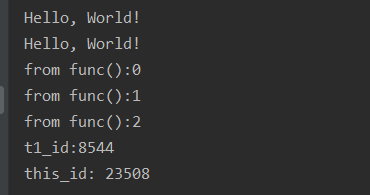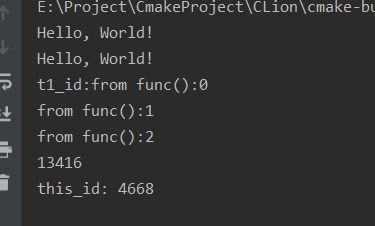C++11多线程编程
1. 多线程编程
在进行桌面应用程序开发的时候, 假设应用程序在某些情况下需要处理比较复杂的逻辑, 如果只有一个线程去处理,就会导致窗口卡顿,无法处理用户的相关操作。这种情况下就需要使用多线程,其中一个线程处理窗口事件,其他线程进行逻辑运算,多个线程各司其职,不仅可以提高用户体验还可以提升程序的执行效率。
如果要使用Qt的多线程编程的话,可以看这篇
这篇我重点记录一下C++11中的多线程编程方法
2. std::thread
C++11中加入了
std::thread类成员函数:
(1)、get_id:获取线程ID,返回一个类型为std:🧵:id的对象。
(2)、joinable:检查线程是否可被join。检查thread对象是否标识一个活动(active)的可行性线程。缺省构造的thread对象、已经完成join的thread对象、已经detach的thread对象都不是joinable。
(3)、join:调用该函数会阻塞当前线程。阻塞调用者(caller)所在的线程直至被join的std::thread对象标识的线程执行结束。
(4)、detach:将当前线程对象所代表的执行实例与该线程对象分离,使得线程的执行可以单独进行。一旦线程执行完毕,它所分配的资源将会被释放。
(5)、native_handle:该函数返回与std::thread具体实现相关的线程句柄。native_handle_type是连接thread类和操作系统SDK API之间的桥梁,如在Linux g++(libstdc++)里,native_handle_type其实就是pthread里面的pthread_t类型,当thread类的功能不能满足我们的要求的时候(比如改变某个线程的优先级),可以通过thread类实例的native_handle()返回值作为参数来调用相关的pthread函数达到目录。This member function is only present in class thread if the library implementation supports it. If present, it returns a value used to access implementation-specific information associated to the thread.
(6)、swap:交换两个线程对象所代表的底层句柄。
(7)、operator=:moves the thread object
(8)、hardware_concurrency:静态成员函数,返回当前计算机最大的硬件并发线程数目。基本上可以视为处理器的核心数目。
另外,std:🧵:id表示线程ID,定义了在运行时操作系统内唯一能够标识该线程的标识符,同时其值还能指示所标识的线程的状态。Values of this type are returned by thread::get_id and this_thread::get_id to identify threads.
有时候我们需要在线程执行代码里面对当前调用者线程进行操作,针对这种情况,C++11里面专门定义了一个命名空间this_thread,此命名空间也声明在
2.1 创建一个线程
直接使用std::thread 来实例化
#include <iostream>
#include <thread>
#include <stdlib.h> //sleep
using namespace std;
void t1()
{
for (int i = 0; i < 10; ++i)
{
cout << "博客园-进击的汪sir\n";
sleep(1);
}
}
void t2()
{
for (int i = 0; i < 20; ++i)
{
cout << "1111111111111\n";
sleep(1);
}
}
int main()
{
thread th1(t1); //实例化一个线程对象th1,使用函数t1构造,然后该线程就开始执行了(t1())
thread th2(t2);
th1.join(); // 必须将线程join或者detach 等待子线程结束主进程才可以退出
th2.join();
//or use detach
//th1.detach();
//th2.detach();
cout << "here is main\n\n";
return 0;
}
2.2 lambda表达式
用lambda表达式来执行多线程非常的方便,适合处理一些比较小的任务
std::thread t3([](int a, double b){cout << a << ' ' << b << endl;}, 3, 4);
3. join与detach的区别
每一个程序至少拥有一个线程,那就是执行main()函数的主线程,而多线程则是出现两个或两个以上的线程并行运行,即主线程和子线程在同一时间段同时运行。而在这个过程中会出现几种情况:
主线程先运行结束
子线程先运行结束
主子线程同时结束
在一些情况下需要在子线程结束后主线程才能结束,而一些情况则不需要等待,但需注意一点,并不是主线程结束了其他子线程就立即停止,其他子线程会进入后台运行
3.1 join()
join()函数是一个等待线程完成函数,主线程需要等待子线程运行结束了才可以结束
#include <iostream>
#include "thread"
using namespace std;
void func()
{
for(int i = 0; i <3; i++)
{
cout << "from func():" << i << endl;
}
}
int main() {
std::cout << "Hello, World!" << std::endl;
std::cout << "Hello, World!" << std::endl;
thread t1(func);
thread::id t1_id = t1.get_id();
thread::id this_id = this_thread::get_id();
t1.join();
std::cout << "t1_id:" << t1_id << endl;
std::cout << "this_id: " << this_id <<endl;
return 0;
}
运行结果

3.2 detach()
称为分离线程函数,使用detach()函数会让线程在后台运行,即说明主线程不会等待子线程运行结束才结束
通常称分离线程为守护线程(daemon threads),UNIX中守护线程是指,没有任何显式的用户接口,并在后台运行的线程。这种线程的特点就是长时间运行;线程的生命周期可能会从某一个应用起始到结束,可能会在后台监视文件系统,还有可能对缓存进行清理,亦或对数据结构进行优化。另一方面,分离线程的另一方面只能确定线程什么时候结束,发后即忘(fire andforget)的任务就使用到线程的这种方式
#include <iostream>
#include "thread"
using namespace std;
void func()
{
for(int i = 0; i <3; i++)
{
cout << "from func():" << i << endl;
}
}
int main() {
thread t1(func);
thread::id t1_id = t1.get_id();
std::cout << "Hello, World!" << std::endl;
thread::id this_id = this_thread::get_id();
t1.detach();
std::cout << "Hello, World!" << std::endl;
std::cout << "t1_id:" << t1_id << endl;
std::cout << "this_id: " << this_id <<endl;
return 0;
}
运行结果



